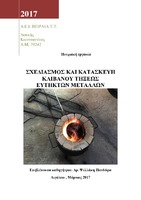| dc.contributor.advisor | Ψυλλάκη, Πανδώρα | |
| dc.contributor.author | Λουκής, Κωνσταντίνος | |
| dc.date.accessioned | 2017-04-06T10:04:21Z | |
| dc.date.available | 2017-04-06T10:04:21Z | |
| dc.date.issued | 2017-03-09 | |
| dc.identifier.uri | http://okeanis.lib2.uniwa.gr/xmlui/handle/123456789/3396 | |
| dc.description.abstract | Στην παρούσα πτυχιακή εργασία μελετήθηκε η δυνατότητα κατασκευής και η απόδοση κλιβάνου τήξης με κατανάλωση αερίου καυσίμου, σε ημι-βιομηχανική κλίμακα. Κλίβανοι αυτού του τύπου θα μπορούσαν να χρησιμοποιηθούν είτε για την τήξη καθαρών μετάλλων που λαμβάνονται μετά την προπαρασκευή και τον εμπλουτισμό ορυκτών πρώτων υλών, είτε για την ανάτηξη ανακυκλούμενων μεταλλικών υλικών παρόμοιας χημικής σύστασης.
Προκειμένου να προσεγγισθεί σφαιρικά το πρόβλημα, πραγματοποιήθηκε καταρχήν σχετική βιβλιογραφική μελέτη, η οποία συνοψίζεται στα ακόλουθα: Πυρομεταλλουργικές διεργασίες για τη λήψη μεταλλικού τήγματος δεδομένης χημικής σύστασης (ξήρανση , φρύξη , τήξη , πύρωση , απόσταξη - εξάχνωση). Κλίβανοι που χρησιμοποιούνται ανά διεργασία και μέταλλο και προβλήματα που θα πρέπει να αντιμετωπισθούν ανά περίπτωση.
Προστασία κλιβάνων με τη χρήση πυράντοχων/ πυρίμαχων εσωτερικών επενδύσεων και προβλήματα που θα πρέπει να αντιμετωπισθούν κατά περίπτωση. Ενεργειακές απαιτήσεις κλιβάνων τήξης και απόδοσή τους. Στη συνέχεια, παρουσιάζεται η σχεδιομελέτη και κατασκευή κλιβάνου τήξης εύτηκτων πρώτων υλών από ανακύκλωση, ο οποίος χρησιμοποιεί ως καύσιμη ύλη το προπάνιο. Συγκεκριμένα, μελετήθηκε και παρουσιάζεται, για την ειδική περίπτωση τήξης ανακυκλούμενων απορριμμάτων αλουμινίου και κραμάτων του: Ο διαστασιακός υπολογισμός ενός τέτοιου κλιβάνου από μέρη/ υλικά που μπορεί κάποιος να βρει εύκολα σε σημεία ανακύκλωσης. Η μελέτη της προστασίας των εσωτερικών τοιχωμάτων του κλιβάνου από τη διαβρωτική δράση του υγρού μετάλλου.
Το θερμικό ισοζύγιο για την τήξη συγκεκριμένης ποσότητας πρώτης ύλης. Το κόστος ανά μονάδα βάρους παραγόμενου για την καύσιμη ύλη που χρησιμοποιήθηκε. Τέλος, έγινε συγκριτική αξιολόγηση της προτεινόμενης λύσης σε σχέση με εναλλακτικές, βάσει του κόστους και των λοιπών ωφελειών από τη χρήση προπανίου ως καύσιμης ύλης | el |
| dc.format.extent | 130 | el |
| dc.language.iso | el | el |
| dc.publisher | Α.Ε.Ι. Πειραιά Τ.Τ. | el |
| dc.rights | Αναφορά Δημιουργού-Μη Εμπορική Χρήση-Όχι Παράγωγα Έργα 3.0 Ελλάδα | * |
| dc.rights.uri | http://creativecommons.org/licenses/by-nc-nd/3.0/gr/ | * |
| dc.subject | TPSH::Τεχνολογία::Μεταλλουργεία | el |
| dc.title | Σχεδιασμός και κατασκευή κλιβάνου τήξεως εύτηκτων μετάλλων | el |
| dc.title.alternative | Design and construction of furnace to melt fusible metals | el |
| dc.type | Πτυχιακή εργασία | el |
| dc.contributor.committee | Τσολάκης, Αντώνιος | |
| dc.contributor.department | Τμήμα Μηχανολόγων Μηχανικών Τ.Ε. | el |
| dc.contributor.faculty | Σχολή Τεχνολογικών Εφαρμογών | el |
| dc.subject.keyword | Μέταλλα | el |
| dc.subject.keyword | Μεταλλεύματα | el |
| dc.subject.keyword | Κλίβανοι | el |
| dc.subject.keyword | Πυρίμαχα υλικά | el |
| dc.subject.keyword | Ανακύκλωση | el |
| dc.description.abstracttranslated | In the current thesis, the aim is to study the ability to construct furnaces and to measure the output of melting with the use of fuel gas on a semi-industrial scale. Furnaces of this type can be used either in the melting of pure metals resulting from the preparation and the enrichment of raw material minerals or the re-melting of recycled metallic materials of a similar chemical composition. In order to approach the problem spherically, I initially conducted the relative bibliography research which is summarized in the following:
Use of fire for metallurgical processes regarding the input of liquefied metal with the given chemical composition (drying , calcilation , liquification , roasting , distillation).
Furnaces utilized for each process and the use of different metals, and the need to address the problems in each case. Preservation of the furnaces through the use of fireproof internal casing and the problems that need to be addressed where applicable.
Energy requirements for melting furnaces and their output. Subsequently, the design and construction of melting furnaces and meltable raw materials resulting from recycling occurs which utilizes propane as a fuel. More specifically, the study presented that for the specific case of melting recycled refuse of aluminum and its alloys: The dimensional calculation of such a furnace composed of materials that someone can easily find in recycling locations. The preservation of the internal furnace panels from the corrosive effects of the liquid metal. The insulating equilibrium for the melting of the specific raw material quantity. The cost per unit weight produced for the fuel utilized. In conclusion, a comparative evaluation was made for the proposed solution with alternatives based on cost, and other benefits acquired from the use of propane as fuel. | el |


